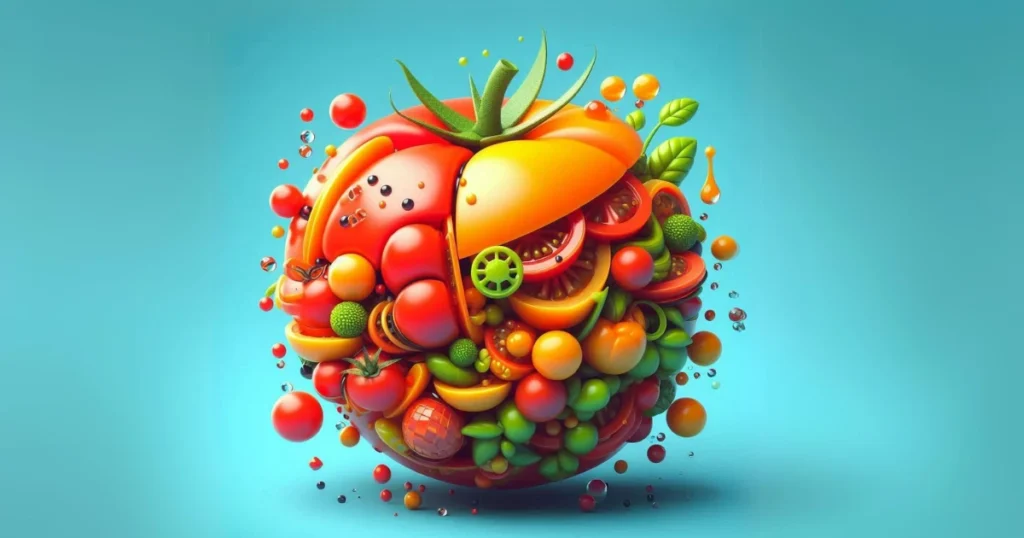
One of the most useful summer fruits and vegetables is probably the tomato. They usually go with vegetables in cooking, but you may have also heard them referred to as fruits.
This piece talks about whether tomatoes are fruits or vegetables and why people sometimes get them mixed up.
Difference Between a Fruit and a Vegetable?
Many people focus on the health benefits of fruits and vegetables due to their high fiber, vitamin, and mineral content.
Fruits and vegetables are similar in many ways, but they are also very different in others.
However, if you converse with a farmer or a cook, these distinctions will be significantly different.
Botanical Classification
Using the shape and function of the part of the plant as the main guide, botanists group fruits and vegetables together.
The flowers turn into fruits, which have seeds and help the plant reproduce. Apples, peaches, blueberries, and raspberries are all popular fruits.
On the other hand, what are vegetables? They are the plant’s stems, leaves, roots, or other helper parts. Spinach, lettuce, carrots, beets, and celery are all well-known veggies.
Classification of Food
Botanical groupings of fruits and vegetables differ significantly from those formed after cooking.
Most people use and apply fruits and vegetables in cooking based on how they taste.
As a general rule, fruit is soft and leans toward being sweet. It might also taste a little tart or sour. It pairs well with cakes, pastries, smoothies, jams, or as a standalone snack.
On the other hand, vegetables usually taste blander and maybe even bitter. Vegetables are typically tougher than fruit, and while some people prefer them raw, others require cooking. They work best in savory recipes like stews, salads, casseroles, and stir-fries.
Botanically, Is Tomato a Fruit
According to scientists, tomatoes are vegetables. All fruits originate from a plant’s flower and contain one or more seeds.
Like all real fruits, tomatoes start out as small yellow flowers on a plant and naturally have a lot of seeds inside them. You can collect these seeds in the future and use them to grow more tomato plants.
It’s interesting that some modern tomato types have been grown on purpose to stop making seeds. However, in botanical terms, a tomato is still the plant’s fruit even when this is the case.
Often Classified as a Vegetable
The widespread culinary applications of tomatoes contribute significantly to the confusion surrounding their classification as fruits or vegetables.
Cooking is a combination of science and art, which results in a greater degree of flexibility in the classification of various cuisines.
People typically use tomatoes in savory preparations, either on their own or in combination with other real vegetables. As a result, they have gained recognition as a vegetable, even though scientific standards technically classify them as a fruit.
In a legal dispute with a tomato importer in 1893, the US Supreme Court used this classification method, arguing that classifying his tomatoes as fruits would allow him to avoid the higher vegetable tariff.
The court decided in this case to classify the tomato as a vegetable based on its culinary uses rather than its botanical classification as a fruit. The remainder is history.
But tomatoes are not the sole product that experiences this type of identity crisis. In fact, the culinary arts often use plants classified as fruits as vegetables.
Other fruits commonly categorized as vegetables are:
- Cucumber
- Squash
- Pea pods
- Peppers
- Eggplant
- Okra
Despite their rarity, some culinary situations occasionally employ vegetables in a manner similar to that of fruits.
For instance, despite its vegetable status, people frequently incorporate rhubarb into delectable dessert-style recipes. Other dishes like carrot cake or sweet potato pie also demonstrate this.
The bottom line
In the botanical sense, tomatoes are considered fruits because they come from a flower and contain seeds
However, the culinary arts most frequently use tomatoes as vegetables. In 1893, the United States Supreme Court ruled that the tomato’s culinary applications warranted its classification as a vegetable.
Culinary practices frequently stray from the scientific definitions of what constitutes a fruit or vegetable. Essentially, many plants classified as vegetables are actually fruits.
In essence, tomatoes are both. If you are conversing with a cultivator or gardener, they are fruits. If you’re conversing with a caterer, they’re a vegetable.
Nevertheless, they are a nutrient-dense and delectable complement to any diet.


